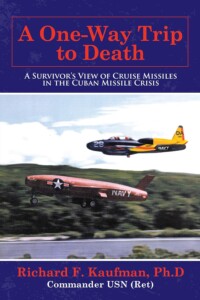Title: A One-Way Trip to Death: A Survivor’s View of Cruise Missiles in the Cuban Missile Crisis
Author: Richard F. Kaufman Ph.D.
Publisher: Archway Publishing
Pages: 148
Genre: Military History
Reviewer: Dan MacIntosh
Pacific Book Review
For those of us old enough to recall the Cold War, Richard F. Kaufman’s first-person recollection of the cruise missile program, and ultimately, the center of the Cuban Missile Crisis, will put some of the pieces from that historic event together for us all. Yes, we recall when the threat of a nuclear war came knocking at our doorstep in the form of Russia colluding with Cuba, not far from the United States’ coast. It was just a little too close to home, though. However, what was it like to be inside one of the planes carrying these missiles? Kaufman’s book gives us an interior perspective on the missile program and what it meant to be a pilot during this critical period in world history.
One of this book’s best chapters is titled “The Kamikaze.” It is exactly what the title says it is. In it, Kaufman details his friendship with Kozo Kagawa, an ex-Kamikaze pilot from World War II. Not long after that horrible war, in 1950, Kaufman attended a lecture given by Kagawa. Not only did Kaufman hear Kagawa speak, but he also befriended the fellow pilot and also visited his home. This was before Kaufman’s experience as a sort of an American Kamikaze pilot, trained to fly missions where there was always a good chance he wouldn’t come back alive. In Kagawa, he found a truly kindred soul.
The chapters that explore the Cuban Missile Crisis are also gripping. We are flies on the wall inside the base where Kaufman awaited his turn to fly a deadly mission. Here, Kaufmann must call his wife and advise her to move to a safer Hawaiian island, away from the potential Soviet target where he’s stationed. As he’s speaking to her, he knows this could possibly be the last time he ever speaks with her. How difficult this must have been! Good thing he didn’t have to fly THAT mission.
Other sections of the book are not quite so emotionally charged. There are lighter moments, such as whenever he and his fellow pilots visited a bar packed with live monkeys — just for the entertainment of its patrons. That’s certainly the kind of bar one would never forget.
There are also chapters dedicated to the nuts and bolts of war programs in which Kaufman participated. Sometimes these included collaborations with submarine fleets. Many times, there were also rivalries between these various branches of the military, which is only natural.
As a writer, Kaufman is a straight-shooting kind of detailer. He doesn’t use a lot of flowery language, nor does he take a poetic tone. Nevertheless, he also avoids using military jargon. This latter approach is especially appreciated by those of us that have never been in the military. Such language might have gotten us really lost, really quickly.
Yes, it is apt to describe this book as a military history work. It looks at history through the lens of a military pilot. However, it is also so much more than just that. Everyone who was alive during the Cold War experienced the doubts and fears associated with the possibility of a nuclear war which had the potential to kill us all. That was a troubling period in world history. Yet, we made it through, only to be replaced by different catastrophic possibilities, including a worldwide pandemic. Thus, this is primarily a history book – and quite a good one at that. We can only hope pilots like Kaufman won’t be necessary in the future. Just don’t hold your breath on that one. For now, though, let’s all hope we can learn a few lessons from Kaufman’s experience.



Follow Us